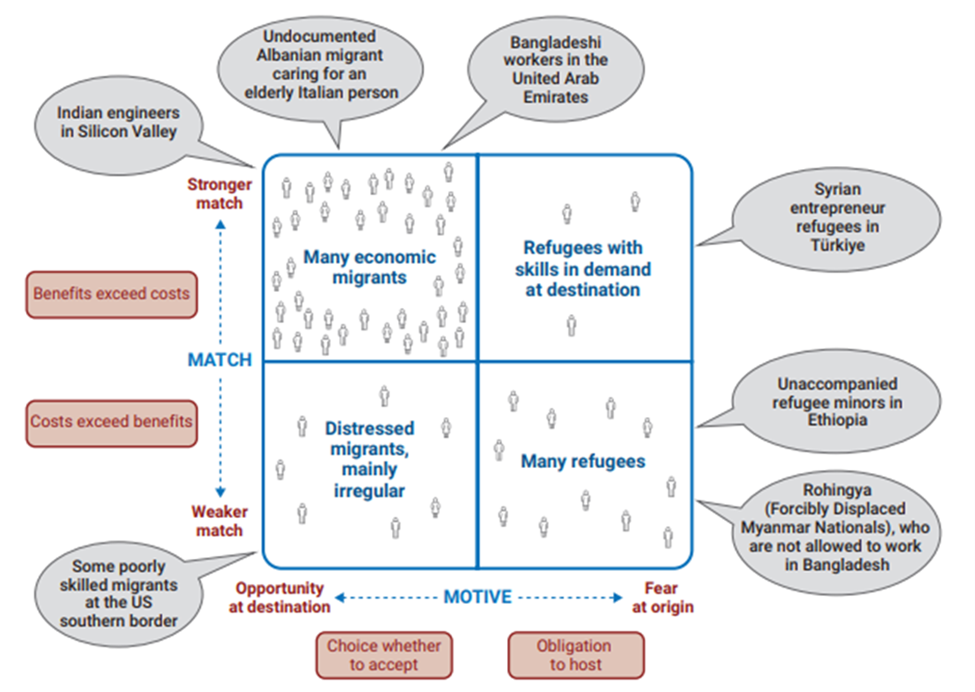Recommended
Last week, the World Bank published the 2023 edition of its World Development Report (WDR), with a focus on “Migrants, Refugees, and Societies.” The report provides a sweeping overview of the issues facing migrants, refugees, and countries of origin, transit, and destination, encapsulating it all in a neat new matrix. While the contents aren’t groundbreaking, the fact it exists at all is. So what does the report include, and why does it matter?
What the report says
The aim of this year’s report is to explore the issues facing migrants and refugees throughout the world, and propose policies to better manage migration in countries of origin, transit, and destination. This is obviously a huge scope, and developing a framework to encapsulate it all is no mean feat. To do so, the report uses a new ‘Match and Motive Matrix,’ as outlined below. The matrix is the report’s way of trying to rationalize the two main perspectives in this space—labor economics and international law—and in so doing, provide a way to discuss a vast array of issues in one report.
Figure 1. The World Bank’s Match and Motive Matrix
Essentially, ‘match’ refers to how well migrants’ skills meet the needs of their countries of destination (a stronger match leads to larger gains) and ‘motive’ refers to the circumstances under which someone moves. As Figure 1 shows, different groups of migrants fall into different categories, often as a result of policies in the country of destination. These categories require different policy responses. For example, for refugees with a strong match, we should be trying to increase their net gains, whereas for refugees with a weak match, we should be trying to reduce and share the cost of hosting.
The report aims to move away from a binary distinction between ‘bad’ migrants and ‘good’ refugees, and instead focus on the policy responses that can support or hinder their contributions to their new economies and societies. Countries of destination are implored to expand legal pathways for entry and remove barriers that prevent migrants and refugees from fully accessing the labor market (such as recognising qualifications and providing the right to work). Countries of origin are asked to make labor emigration part of their development strategy, engaging in bilateral cooperation to increase the benefits (such as remittances) and reduce the costs (such as brain drain) of movement.
To briefly toot our own horn, it’s heartening to see the impact of CGD’s research and policy engagement come through in the report. Michael Clemens’ vast body of work is cited 63 times, exploring the economic gains from expanded migration; the wage premium migrants can earn; and the impact of migration pathways, among many other things. The research conducted by Thomas Ginn and the #LetThemWork initiative is showcased in the section on refugee policy. Finally, our Global Skill Partnership model is repeatedly showcased as a form of bilateral cooperation that must be implemented more broadly. It is also heartening to see our long-held and -espoused view that migration can be a development opportunity finally gaining widespread support.
Why it matters
On the face of it, the statements contained within the 2023 WDR are hardly revolutionary. Migration is neither good nor bad; it is policies that determine its impact. Rapid demographic change means migration will become increasingly necessary for countries at all income levels to meet labor shortages and advance economic development. Economic migrants move to places where there is a demand for their skills, regardless of distance, while refugees prioritize safety and security, often in neighboring countries. Both countries of origin and destination should expand managed labor migration.
So why do these statements matter?
Firstly, we shouldn’t take for granted the fact that they were accepted by countries at all income levels. The controversy surrounding the signing of the Global Compact for Migration, as well as recent policy moves to scale back commitments to asylum and refugee obligations, show that these issues are highly contentious. Take a WDR focused on education, for example. All countries would agree with the central premise—education is good—though they may quibble about how to best reach the various goals under that. Getting the same countries to accept that migration is good would have been an uphill battle at best, but it paves the way for future cooperation on the issue.
Secondly, it could influence the discourse in this area. Previous WDRs have had a large and lasting impact on the way that important development issues are framed and invested in. As Banerjee et al note, the 1990 WDR on poverty introduced the $1-a-day measure, and the 1993 WDR on health introduced the concept of the global burden of disease, spurring Bill Gates to create his foundation. We hope that this WDR will have a similar effect on the discourse, framing migration as a major development opportunity to be harnessed.
Thirdly, it could influence World Bank thinking and lending in this area. The 2012 WDR on gender, for example, heavily influenced World Bank strategic thinking and lending on such issues; and the 1994 WDR on infrastructure moved World Bank practice (for good and ill) towards a focus on privatization. Teams apparently fight to have the next WDR focused on their area of practice. The new World Bank Director, Ajay Banga, has already been engaged in migration issues and may seek to continue this focus. Doing so would require the World Bank to address some fundamental constraints, namely the lack of incentives and tools to support cross-border projects and the fact that migration sits awkwardly over multiple practice teams. Yet doing so will be essential if they are to realize the vision set out in this report.
Disclaimer
CGD blog posts reflect the views of the authors, drawing on prior research and experience in their areas of expertise. CGD is a nonpartisan, independent organization and does not take institutional positions.
Image credit for social media/web: Adobe Stock







